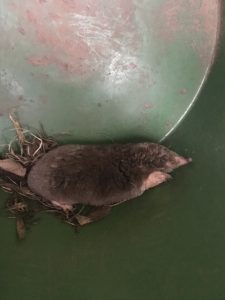Kansas City Mole Control
Do you need to get rid of squirrels in moles? Call now for same day service
Some Geographic Restrictions

Moles in Kansas City
Moles are a common problem in yards and gardens in Kansas City. People’s lawns and gardens usually have ideal soil conditions for moles with plenty of food sources. It can be tricky to remove unless you know how to get rid of moles using proper mole control techniques.
When you have a mole problem, you will notice mounds of disturbed soil in your garden or lawn from the moles burrowing. Moles burrow because they are looking for food and have sensitive eyes so they remain underground or protected by foliage when possible.
Mole Removal Services

Mole Removal
Moles dig extensive tunnels so it takes skill and experience to successfully target them. Mole traps are the most effective method to control a mole population in your backyard.

Mole Control
It is not feasible to exclude your entire yard from moles. We can install mole exclusions to keep the pest away from certain parts of your yard like gardens, landscaping, and ornamental trees.

Maintenance
Moles are territorial, and your property has food sources that attract moles. After we control the initial infestation, we can help keep your yard free from moles.

Signs a Moles in Your Yard
Moles spend almost their entire time underground. The clearest signs of a mole problem in the yard are the molehills and mole tunnels.
These are the distinguishing factors for moles:
- Raised mounds of dirt at tunnel entrances
- Raised ridges crisscrossing the lawn and garden beds
- Areas of your lawn where the soil is spongy beneath your feet
- Discolored grass where moles have dug through roots
- Weed growth where lawn is dying

Dangers of Mole Infestation
The damage from moles burrowing and digging generally outweighs immediate hazards, such as getting bit or diseases they may carry. They often uproot grass, and create mounds, ridges, and tunnels in yards, flowerbeds, and gardens. Other rodents will use the tunnels and often eat the exposed roots of plants in a garden or flowerbed.
The tunnels can still do extensive damage to lawns and may dig enough voids around the foundation to cause settling and cracking. Just one or two moles on your property can destroy the majority of your lawn over a few months.
Some Geographic Restrictions
Frequently Asked Questions
The easiest way to identify mole damage to lawns is the presence of tracks and mounds. These are created as the pests tunnel just below the surface of the ground, overturning dirt with their powerful front feet. Their tracks can become so extensive that they intertwine like labyrinths, and dirt mounds found in yards are usually the entrances to burrows.
Gardens can be destroyed in no time by an infestation of moles, as a single pest can tunnel one foot per minute in the right soil conditions. While they don’t eat plants, moles do destroy their roots as they tunnel. Additionally, moles dig deeper into the ground for sleeping, mating, and riding out extreme weather. These can be as deep as 24 inches and cause sections of a yard to cave-in.
Moles can be extremely difficult to remove because they spend so much time underground and are unusually fast for their size. Common prevention tactics include castor oil-based repellents, annual lawn grub treatments, and planting certain bulb plants like garlic, shallots, and daffodils. However, these hardly work as long-term means of controlling mole damage. Trapping is the most effective way to get rid of infestations but is dangerous without a professional. To ensure that moles won’t do further damage to the yard, contact the skilled staff at Trutech.
Moles are known carriers of rabies, which is typically transmitted to humans through the saliva of infected animals. While moles tend to be shy, they will bite if they feel confused, threatened, or when they’re handled. However, people are more likely to contract a mole disease from the pests that live in their fur. Ticks and fleas can carry Lyme disease, Rocky Mountain spotted fever, anaplasmosis, and tularemia.
Moles prefer to live in cool, moist soil, and their diet consists of the insects found underground. As such, they rarely surface and instead spend most of their time in elaborate tunnel systems of their own creation. However, they may find themselves in basements on occasion.
Older homes with dirt floors are the most likely to have a mole in the basement. Additionally, moles may enter basements through gaps in building foundations or open cellar doors or windows. Property owners who encounter moles in basements should assume that the pest is lost or confused.
Since residential neighborhoods are often built on the loose soil that moles prefer to live in, property owners and the pests share many close encounters. Though they are more likely to be found in yards and gardens, moles may unintentionally find themselves in garages. Most often, this happens when the pests burrow underneath homes and get into garages through holes or gaps in the foundation.
However, moles may also wander into garages aboveground or be carried in by pets. Though moles do not typically enter garages on purpose, the spaces are damp, dark, and moist, which is the kind of environment these pests enjoy most. Still, they need access to soil and food to survive and do not usually stay in garages for long.
When moles enter homes, it’s typically by accident. Most infestations occur outdoors in gardens and yards. Since the pests are known for their tunneling behavior and live primarily in underground burrows, they generally need to stay outside in the soil. Nevertheless, residents may find moles in the house in basements and cellars from time to time. In most of these cases, the moles are invading older homes with dirt floors, cracks in the foundation, or gaps in the basement windows and panes.
Insects and grubs are moles’ main food sources. Digging through the ground builds up a large appetite, which means that moles are constantly on the hunt for worms, beetle larvae, and other insects found within the soil. Since moles’ favorite foods are typically attracted to gardens by roots or decaying plant matter, flower beds are excellent hunting grounds for the pests. Additionally, garden soil is generally loose and moist, which makes it easy for moles to tunnel through.
Many animals burrow and make different holes in your hard. Burrowing animals include voles, gophers, and chipmunks. Raccoons, skunks, and opossums also can dig up your yard.


